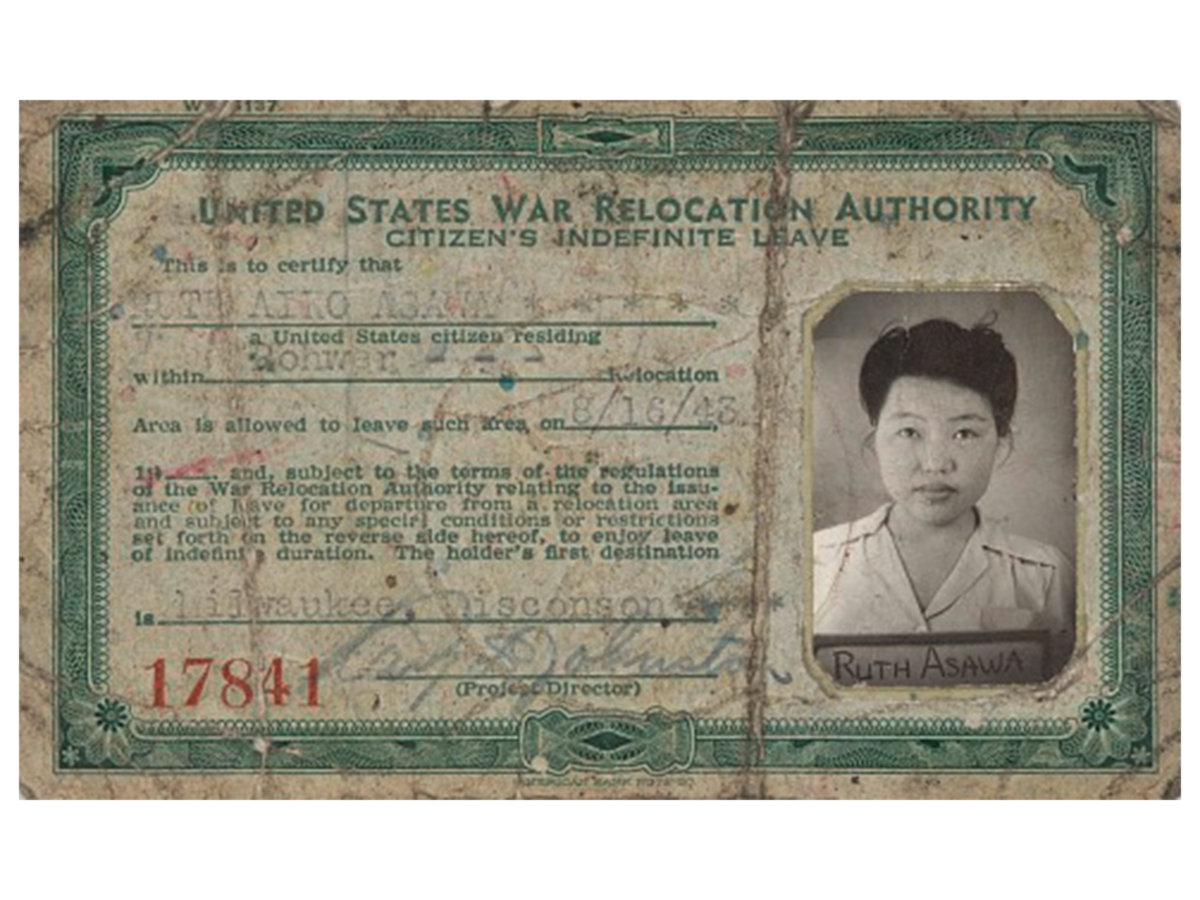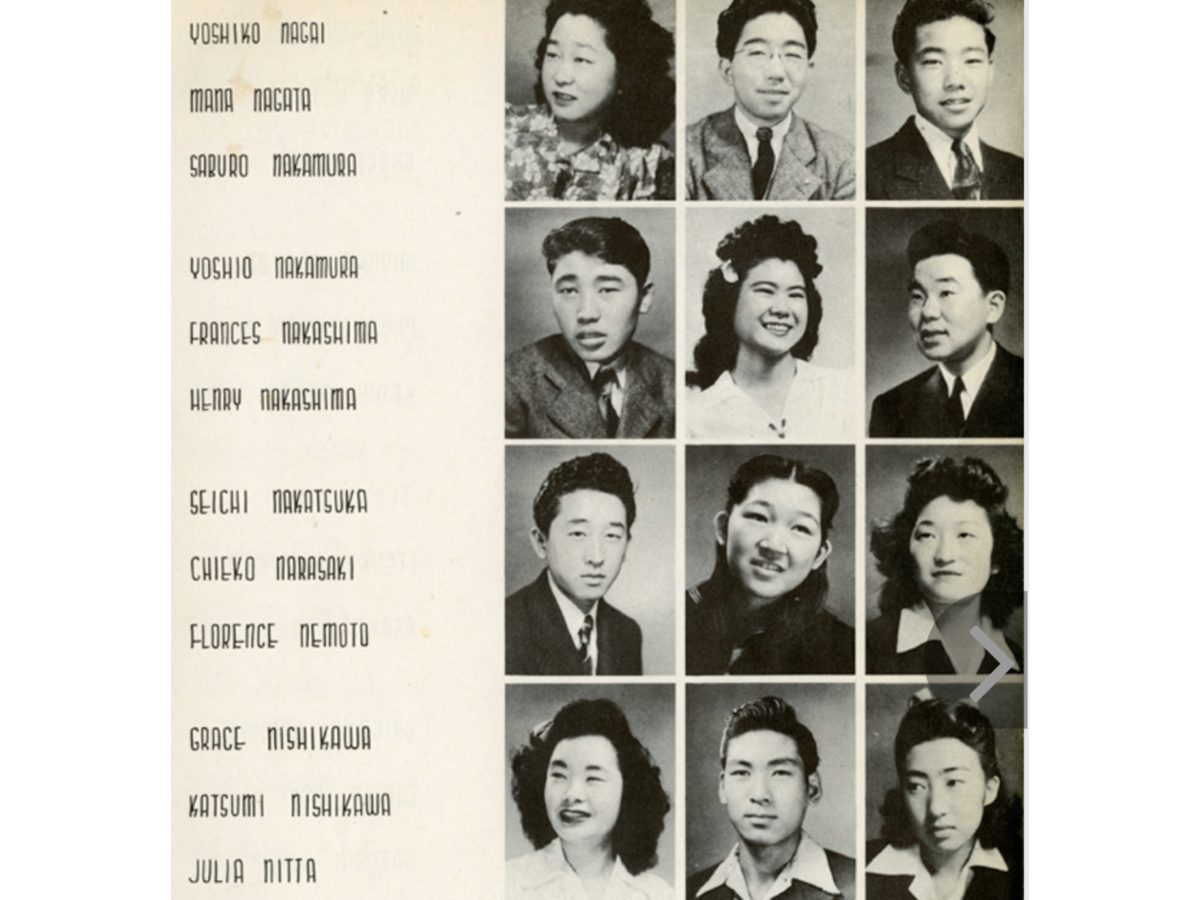Activity
The Japanese American Incarceration Experience: Loyalty and Civil Rights
Objective: Students will examine the experiences and perspectives of incarcerated Japanese Americans during World War II.

View primary source documents including Ruth Asawa’s incarceration camp ID.
Content Standards
English Language Arts
W.4.8: Recall relevant information from experiences or gather relevant information from print and digital sources; take notes, paraphrase, and categorize information, and provide a list of sources.
W.4.9.a,b: Draw evidence from literary or informational texts to support analysis, reflection, and research.
National Standards for Civics and Government
Standard I.C.2: Explain the various purposes served by constitutions.
Standard IV.B.2: Evaluate, take, and defend positions on foreign policy issues in light of American national interests, values, and principles.
Standard IV.B.1: Evaluate, take, and defend positions on issues regarding personal rights.
Standard IV.B.1: Evaluate, take, and defend positions on issues regarding political rights.
History and Social Science
HSS-10.8: Students analyze the causes and consequences of World War II.
HSS-11.7: Students analyze America’s participation in World War II.
HSS 11.7.5: Discuss the constitutional issues and impact of events on the U.S. home front, including the internment of Japanese Americans
HSS-PoAD.12.2: Students evaluate and take and defend positions on the scope and limits of rights and obligations as democratic citizens, the relationships among them, and how they are secured.
Guiding Questions
- Why was the United States so concerned about determining Japanese loyalty?
- How does loyalty change during wartime?
- How should loyalty be determined?
- Do you always have to agree with government policies to be loyal?
- In what ways can citizens express dissent if they do not believe in government policies?
Materials
- Internet access
- Sound speakers
- Projector
- Virtual archive of the Rohwer Center High School Yearbook
- Video: Ugly history: Japanese American incarceration Camps: https://youtu.be/hI4NoVWq87M
- Questionnaire distributed to male U.S. citizens of Japanese ancestry over the age of 17, commonly known as the “Loyalty Questionnaire”
Background
Ruth Asawa was one of many Japanese Americans incarcerated after the signing of Executive Order 9066. The Asawa family was forced to sell their farm and relocate to an incarceration camp. Asawa’s experience is illustrative of discrimination and the violation of American civil rights during the WWII era.
Vocabulary
Nisei (noun) – a child of Japanese immigrants who is born and educated in America and especially in the U.S.
Source: Merriam-Webster
Issei (noun) – a Japanese immigrant especially to the U.S.
Source: Merriam-Webster
Loyal (adjective) – unswerving in allegiance, faithful to one’s lawful sovereign or government. b: faithful to a private person to whom faithfulness is due: a loyal husband. c: faithful to a cause, ideal, custom, institution, or product: a loyal churchgoer, loyal to the party of their forebears
Source: Merriam-Webster
Assimilate (verb) – to absorb into the cultural tradition of a population or group to make similar
Source: Merriam-Webster
Procedure
- Begin by introducing Executive Order 9066 along with historical context, if not previously covered.
- Executive Order 9066: Executive Order 9066: The President Authorizes Japanese Relocation
- View this TedEd video with your class about the experience of Aki Kurose: https://youtu.be/hI4NoVWq87M
- Virtually view the Rowher Center High School Yearbook; while viewing, ask students to read the comments and labels. Have students record any comments that are notable or out of the ordinary.
- Ask students to consider what daily life looked like in an incarceration camp; what things would have been prohibited that would affect a normal life? Have students refer to the yearbook and video in their responses.
- Option to share in groups or complete a journal prompt.
- Option to show “U.S. Propaganda Film Clip of ‘Normal’ Life in WWII Japanese Incarceration Camps”: https://www.history.com/news/japanese-american-internment-camps-wwii
- Discuss the treatment of prisoners in the incarceration camp. Lead a class discussion on student comments from the prior step. Introduce the definition of “loyalty” from Merriam-Webster and the guiding questions.
- Ask students to consider loyalty in the time of WWII and Japanese American incarceration, many nisei and issei were feared to be spies for the Axis powers and considered “public dangers.” Why did the United States feel the need to ensure loyalty? How can loyalty be determined? Do you have to agree with the government to be loyal? Does a Japanese American have to give up their cultural connections to be loyal?
- View the Loyalty Questionnaire. Explain that refusing to complete the questionnaire, providing qualified answers, or answering “no” to questions 27 and 28 were treated as evidence of disloyalty. (Burns et. al 2019)
- Have students in groups discuss the ways that loyalty was enforced and upheld; invite students to consider what mechanism the United States government used to assimilate Japanese Americans and remove their connections from Japan.
- Conclude with a class discussion, group poster board projects, or an extension option below.
Poster Board
- Create a visual organizer including content from the sources in the lesson plan. Students should include what Executive Order 9066 was and how it affected Japanese Americans.
Extensions
Ruth Asawa first learned to weave during her incarceration at Rowher, through her volunteer work weaving camouflage nets (Varner 2016). Other artists such as Chiura Obata, Kay Sekimachi, and Arthur Okamura were also incarcerated during WWII and found solace through creating or teaching art. Have students explore the artwork made by Japanese American prisoners in the incarceration camps. Here are a few places to start:
- Video: “The Art of Gaman: Arts and Crafts from the Japanese American Internment Camps.” Smithsonian Magazine. YouTube Mar. 17, 2010.
- Stamberg, Susan. “The Creative Art of Coping in Japanese Internment.” May 12, 2010. https://www.npr.org/templates/story/story.php?storyId=126557553
- “Artistic Expression.” The United States in World War II: Historical Debates about America at War. Oberlin College History 244 Virtual Exhibition. Accessed May 22, 2020. http://oberlinlibstaff.com/omeka_hist244/exhibits/show/japanese-internment/arts
- Ahn, Abe. “Years After Controversial Sale, Artworks from Japanese Internment Camps Go on View.” Hyperallergic. Feb. 21, https://hyperallergic.com/427975/contested-histories-japanese-american-national-museum/
Discuss: What can you learn about the Japanese American prisoners from looking at their artwork?
- Include a discussion and writing assignment pertaining to the First, Fourth, and Fifth Amendments to the Constitution. Direct students to analyze how Japanese American rights were violated, and what legal considerations led to the rulings of Korematsu v. United States and Endo v. the United States.
- Dramatic presentations: Divide students into groups and instruct them to complete a short dialogue discussing life in incarceration camps. Further instructions can be found at Japanese-American Internment During World War II.





